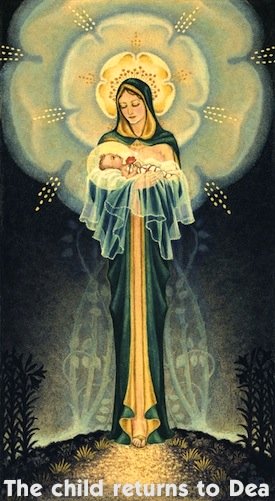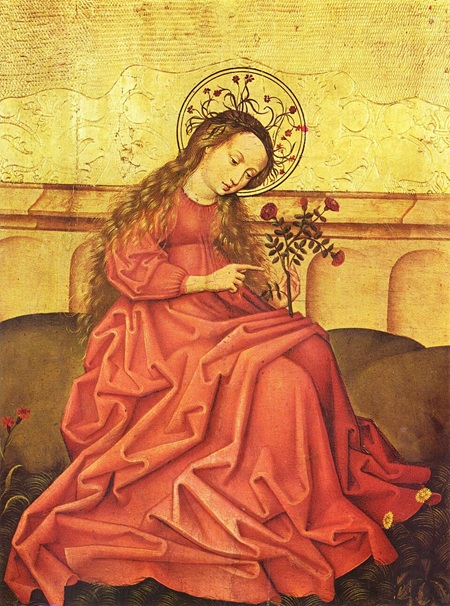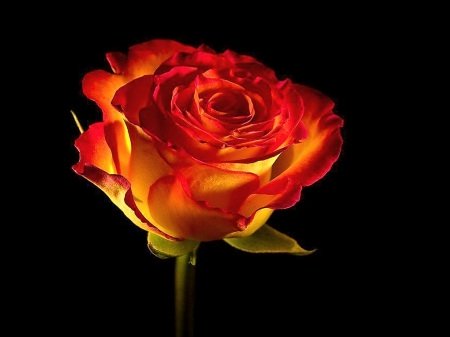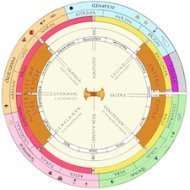The High Feast of Rosa Mundi
The Rose of the World

Rosa Mundi is the Summer Solstice Festival of Our Mother God. It is the first High Feast of the Mother Half of the year. It represents the southern pole of the World Axis and the Southern Gate of Heaven.
After the "narrative" festivals of the Daughter Half, Rosa Mundi may seem a little abstract in its meaning. It is the polar opposite of the Winter Solstice festival of Nativity. While Nativity is the feast of the descent of God (in the form of the Daughter) to earth, Rosa Mundi is the feast of the ascent of maid to Heaven (in the form of the Mother).
Rosa Mundi immediately follows (in terms of the Great Festivals) the Exaltation, the feast of the Daughter's re-ascent to Heaven. Thus, in a sense, we are following the Daughter back to our home in the Mother.
Since Heaven is not only "upward" but "inward" – inward toward our own heart, which is not other than the Heart and Center of all being, the journey prefigured in the Rosa Mundi festival is also into "the innermost temple of your heart, whose form is the form of a rose".
So, in a sense we may say that the meaning of the festival is mystical and relates to human perfection, and yet like every festival, it is a feast for all people and it is wise not to over-mysticize it. Like every festival, it can be seen as profoundly or as popularly as each soul needs to find it.
So what is the popular nature of the festival? Rosa Mundi is one of the three great Fire Festivals (the other two are Tamala and the Day of Sai Herthe. On the most popular level, Rosa Mundi is the day of a big bonfire, as well as the day on which roses are honored in various ways, from decorating altars and temples to giving them to friends.
The whole season of Rosa Mundi (which can vary in length according to local custom but always covers at least several days following the festival and some hold it to last until the Golden Festival of Chelanya) is known as the Fire and Rose season. The two themes, obviously, are fire and roses, and it is not coincidental that in various forms of the Sleeping Beauty story the sleeping Princess may be guarded by thorny briar roses (the Sleeping Beauty's name is Briar Rose) or by fire (cf, Brünnhilde sleeping on the fire-girt rock).
The secret behind all this is that the Sleeping Beauty is the Spirit herself, the Guarded Treasure. Fire and the Rose are ambiguous in this context, in that both are Treasures ("fire-worship" is very important in Aristasia, note for example the great Fire Temples, like that at Rayapurh) and both are Guardians – even the lovely Rose with her thorns.
So, ultimately the joyous Fire and Rose season, with its flowers and its fireworks – like the beautiful fairy tale – is about the soul's quest for the Spirit, for the Temple of the Heart whose form is the form of a Rose. For the sacred Rose whose petals are pure fire.
And this "fusion" of the high-mystical and the joyfully popular is exactly the character of this glorious festival. As with the Fire-Feast of Tamala, we cast branches or other combustible debris on the fire to symbolize our faults and our false selves.
The fact that the "innermost temple of the heart, whose form is the form of a rose" lies within us should not inspire a complacency that we are "already there" (in a very profound sense we are, but that is of no practical significance for our present state). To understand the difficulty of the innermost Temple of our hearts, first we must realize that our individual egos are not there, and are in fact a barrier to entering that Temple which is actually supra-individual. For every heart, in its fundamental state, is the One True Heart, and as distant from us as "Heaven" (which it also is) and yet as near to us as our very Selves.

All these things are made clear in the sutra "The Temple of the Heart" in The Gospel of Our Mother God. We are indeed "already there":
For the Spirit is One, and I am the Spirit. And you are the Spirit also, in the innermost temple of your heart.
And yet the "we" that is there is not our current egoic self, and so the temple is "guarded" from us:
About the temple and encompassing it round grows a garden rank with thorns, which are the thorns of khear
Khear means both the rift, or cosmic separation, between the manifest world and our Mother God, and the individual flaws or rifts within ourself.
It is the overcoming of these thorns and the coming to the Innermost Temple, to the Sleeping Beloved – or, if we put it another way, the pure ascent to Heaven, mirroring the Daughter's descent at the polar-opposite Festival, and following her re-ascent at the previous Festival – that is the True Quest that lies behind all earthly quest stories.
When we talk this way, modern Western minds are liable to truncate the entire Quest – to imagine that sanctity and return are just a short distance from us. In truth the Quest is long and there are no short cuts:
But deep are the roots of the thorns, and beyond your power to destroy them, for they are the roots of Death. 22. Therefore place your trust not in the power of your own hands, and be not raised up with the pride of self-possession, 23. But cast yourself down and give yourselves to Me in quiet humbleness.
And yet each one of us who is faithful, from the smallest child to the highest stravë, is on that Quest, and the High Feast of Rosa Mundi, with its fireworks and its roses is the celebration of that Quest, and also the celebration of our communal participation in that quest, for we are all sisters on the Way. It is in humbleness that we offer our faults, our egoity, our khear to the flames, yet it is in joy that we embrace the Rose, the symbol not only of the final End, but of all the bounty of our Mother God that is with us even in this world:
And She who is the Spirit, My Mother, holds out Her hands to you in happiness beyond all knowing and joy beyond expression of all words. 15. And truly, all sweetness is the far-blown scent of this Sweetness; and all Beauty is the pale and dimmed reflection of this Beauty; and all music but the faint and distant echo of this Music.
And the radiant summer is one of the signs of Her bounty; yet also a manifest sign of the fact that this material universe is not the solid and isolated place that the profane might take it to be: for midsummer – the season of Fire and the Rose – is a time when the veil between worlds is thinner, when fairies, as well as ghosts and other subtle entities are more likely to be seen and when divination and magic are more likely to be effective (the other times when the veil is thinnest are the periods surrounding other two fire festivals). Thus in Deanic circles, Midsummer is as much a time for supernatural tales as Midwinter and the Feast of the Dead. And as with the Midwinter Herthe festival, the driving out of dark spirits is also important.

We are quite deliberately mixing here the "folk" elements of this festival and season with its higher Spiritual elements, because we wish to show the High Feast of the Rose of the World in all the many-layered complexity that it has in the Motherlands, and also to indicate that the distinction between the "high" and spiritual and the "low" and folkish is nowhere near as important as modern Tellurians may imagine.
Even the most "folkish" elements are steeped in the Spirit; even the "highest" elements are suffused with the warmth, brightness and mystery, and sheer fun of this glorious Rosa Mundi season.
See also:
Janua Coeli : Heaven's Gates – on the traditional symbolism of the Summer and Winter Solstices
Mythology and Folklore – on the symbolism of fairy tales
Send us your questions or comments
Chapel of Our Mother God Homepage
All written material at the Chapel of Our Mother God is copyright. Should you wish to reproduce any portion please contact us for permission.
Facebook or Twitter
Wheel of the Year
Articles on the Months, Seasons and Festivals of the year in feminine religion General The High Feast of EastreThe End/Beginning of the Cycle
- All about Eastre: The Last Festival and the First
- An Easter Hymn
- The Marianna Maria Chant
- The True Meaning of the Eastre Egg
- Chelanya: The Feast of Regeneration
- Cuivanya: The Feast of Divine Life
- Tamala: The Feast of the Dead
- All about Nativity
- The Birth of God the Daughter
- Winter Solstice
- The True Meaning of Christmas
- Amaterasu Omikami and the Spiritual Meaning of Midwinter
- The "Christmas Tree"
- The real Christmas Tree Angel
- "Hail to the Princess" carol
- The Day of Our Sovereign Lady
- Maia's Day
- The Day of Werde
- Early Winter Festivals
- The Conception of God the Daughter
- The Day of Sai Herthe
- The Epiphany of Our Lady
See the Wheel of the Year Click below to see the full image of the Sacred Year, or go here for a basic introduction.

Click to enlarge
Once you have enlarged the image you can use the Ctrl + and - keys (Command + and - on a Mac) to resize the Wheel to your exact requirements.Gospel of Our Mother God
The Gospel of Our Mother God is a collection of inspirational texts, prayers and daily inspiration for the Mother-Faith devotee or household.
The Feminine Universe
The Other Philosophy
Everything you have ever heard comes out of the patriarchal world-view. Its materialism, its religion, even its feminism. Here is the other way of seeing the world; the natural way: the way that everyone saw things before patriarchy and will again when patriarchy is long forgotten.

